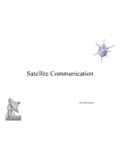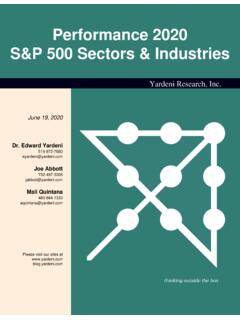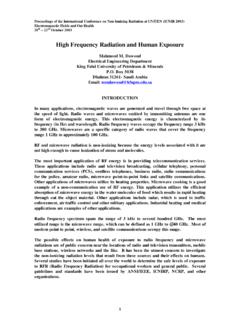Transcription of 1 Wireless Communications with Unmanned Aerial Vehicles ...
1 1. Wireless Communications with Unmanned Aerial Vehicles : Opportunities and Challenges Yong Zeng, Rui Zhang, and Teng Joon Lim [ ] 11 Feb 2016. Abstract Wireless communication systems that include Unmanned Aerial Vehicles (UAVs) promise to provide cost- effective Wireless connectivity for devices without infrastructure coverage. Compared to terrestrial Communications or those based on high-altitude platforms (HAPs), on-demand Wireless systems with low-altitude UAVs are in general faster to deploy, more flexibly re-configured, and are likely to have better communication channels due to the presence of short-range line-of-sight (LoS) links. However, the utilization of highly mobile and energy- constrained UAVs for Wireless Communications also introduces many new challenges. In this article, we provide an overview of UAV-aided Wireless Communications , by introducing the basic networking architecture and main channel characteristics, highlighting the key design considerations as well as the new opportunities to be exploited.
2 I. I NTRODUCTION. with their high mobility and low cost, Unmanned Aerial Vehicles (UAVs), also commonly known as drones or remotely piloted aircrafts, have found a wide range of applications during the past few decades [1]. Historically, UAVs have been primarily used in the military, mainly deployed in hostile territory to reduce pilot losses. with the continuous cost reduction and device miniaturization, small UAVs (typically with weight not exceeding 25 kg) are now more easily accessible to the public and thus numerous new applications in civilian and commercial domains have emerged, with typical examples including weather monitoring, forest fire detection, traffic control, cargo transport, emergency search and rescue, communication relaying, etc [2]. UAVs can be broadly classified into two categories: fixed wing versus rotary wing, each with their own strengths and weaknesses.
3 For example, fixed-wing UAVs usually have high speed and heavy payload, but they must maintain a continuous forward motion to remain aloft, The authors are with the Department of Electrical and Computer Engineering, National University of Singapore (e-mail: {elezeng, elezhang, February 12, 2016 DRAFT. 2. thus are not suitable for stationary applications like close inspection. In contrast, rotary-wing UAVs such as quadcopters, though having limited mobility and payload, are able to move in any direction as well as to stay stationary in the air. Thus, the choice of UAVs critically depends on the applications. Among the various applications enabled by UASs, the use of UAVs for achieving high-speed wire- less Communications is expected to play an important role in future communication systems. In fact, UAV-aided Wireless communication offers one promising solution to provide Wireless connectivity for devices without infrastructure coverage due to , severe shadowing by urban or mountainous terrain, or damage to the communication infrastructure caused by natural disasters [3].)}
4 Note that besides UAVs, one alternative solution for Wireless connectivity is via high-altitude platforms (HAPs), such as balloons, which usually operate in the stratosphere that is tens of kilometers above the Earth's surface. HAP-based Communications have several advantages over the UAV-based low-altitude platforms (LAPs), such as wider coverage, longer endurance, etc. Thus, HAP is in general preferred for providing reliable Wireless coverage for a large geographic area. However, compared to HAP-based Communications , or those based on terrestrial or satellite systems, Wireless Communications with low-altitude UAVs (typically at an altitude not exceeding several kilometers) also have several important advantages. First, on-demand UASs are more cost-effective and can be much more swiftly deployed, which makes them especially suitable for unexpected or limited-duration missions.
5 Besides, with the aid of low-altitude UAVs, short-range line-of-sight (LoS) communication links can be established in most scenarios, which potentially leads to significant performance improvement over direct communication between source and destination (if possible) or HAP relaying over long-distance LoS links. In addition, the maneuverability of UAVs offers new opportunities for performance enhancement, through the dynamic adjustment of UAV state to best suit the communication environment. Furthermore, adaptive Communications can be jointly designed with UAV mobility control to further improve the communication performance. For example, when a UAV. experiences good channels with the ground terminals, besides transmitting with higher rates, it can also lower its speed to sustain the good Wireless connectivity to transmit more data to the ground terminals.
6 These evident benefits make UAV-aided Wireless communication a promising integral component of future Wireless systems, which need to support more diverse applications with orders-of-magnitude capacity improvement over the current systems. Fig. 1 illustrates three typical use cases of UAV-aided Wireless Communications , which are: (a) UAV-aided ubiquitous coverage, where UAVs are deployed to assist the existing communication infrastructure, if any, in providing seamless Wireless coverage within the serving area. Two example February 12, 2016 DRAFT. 3. Fig. 1: Three typical use cases of UAV-aided Wireless Communications . scenarios are rapid service recovery after partial or complete infrastructure damage due to natural disasters, and base station offloading in extremely crowded areas, , a stadium in a sports event.
7 Note that the latter case has been identified as one of the five key scenarios that need to be effectively addressed by the fifth generation (5G) Wireless systems [4]. (b) UAV-aided relaying, where UAVs are deployed to provide Wireless connectivity between two or more distant users or user groups without reliable direct communication links, , between the frontline and the command center for emergency responses. (c) UAV-aided information dissemination and data collection, where UAVs are despatched to dissemi- February 12, 2016 DRAFT. 4. nate (or collect) delay-tolerant information to (from) a large number of distributed Wireless devices, , Wireless sensors in precision agriculture applications. Despite the many promising benefits, Wireless Communications with UAVs are also faced with several new design challenges.
8 First, besides the normal communication links as in terrestrial systems, additional control and non-payload Communications (CNPC) links with much more stringent latency and security re- quirements are needed in UASs for supporting safety-critical functions, such as real-time control, collision and crash avoidance, etc. This calls for more effective resource management and security mechanisms specifically designed for UAV communication systems. Besides, the high mobility environment of UASs generally results in highly dynamic network topologies, which are usually sparsely and intermittently connected [5]. As a result, effective multi-UAV coordination, or UAV swarm operations, need to be designed for ensuring reliable network connectivity [6]. At the same time, new communication protocols need to be designed taking into account the possibility of sparse and intermittent network connectivity.
9 Another main challenge stems from the size, weight, and power (SWAP) constraints of UAVs, which could limit their communication , computation, and endurance capabilities. To tackle such issues, energy-aware UAV deployment and operation mechanisms are needed for intelligent energy usage and replenishment. Moreover, due to the mobility of UAVs as well as the lack of fixed backhual links and centralized control, interference coordination among the neighboring cells with UAV-enabled Aerial base stations is more challenging than in terrestrial cellular systems. Thus, effective interference management techniques specifically designed for UAV-aided cellular coverage are needed. The objective of this article is to give an overview of UAV-aided Wireless Communications . The basic networking architecture, main channel characteristics and design considerations, as well as the key performance enhancing techniques that exploit the UAV's mobility will be presented.
10 II. BASIC N ETWORKING A RCHITECTURE. Fig. 2 shows the generic networking architecture of Wireless Communications with UAVs, which consists of two basic types of communication links, namely the CNPC link and the data link. A. Control and Non-Payload Communications Link The CNPC links are essential to ensure the safe operation of all UASs. Highly reliable, low-latency, and secure two-way Communications , usually with low data rate requirement, must be supported by these links for exchanging safety-critical information among UAVs, as well as between the UAV and ground February 12, 2016 DRAFT. 5. Primary CNPC Link Satellite Secondary CNPC Link Data Link UAV UAV. Ground Control Ground Terminals Station Fig. 2: Basic networking architecture of UAV-aided Wireless Communications . control stations (GCS), , dedicated mobile terminals mounted on ground Vehicles .

![arXiv:0706.3639v1 [cs.AI] 25 Jun 2007](/cache/preview/4/1/3/9/3/1/4/b/thumb-4139314b93ef86b7b4c2d05ebcc88e46.jpg)

![arXiv:1301.3781v3 [cs.CL] 7 Sep 2013](/cache/preview/4/d/5/0/4/3/4/0/thumb-4d504340120163c0bdf3f4678d8d217f.jpg)
![@google.com arXiv:1609.03499v2 [cs.SD] 19 Sep 2016](/cache/preview/c/3/4/9/4/6/9/b/thumb-c349469b499107d21e221f2ac908f8b2.jpg)









